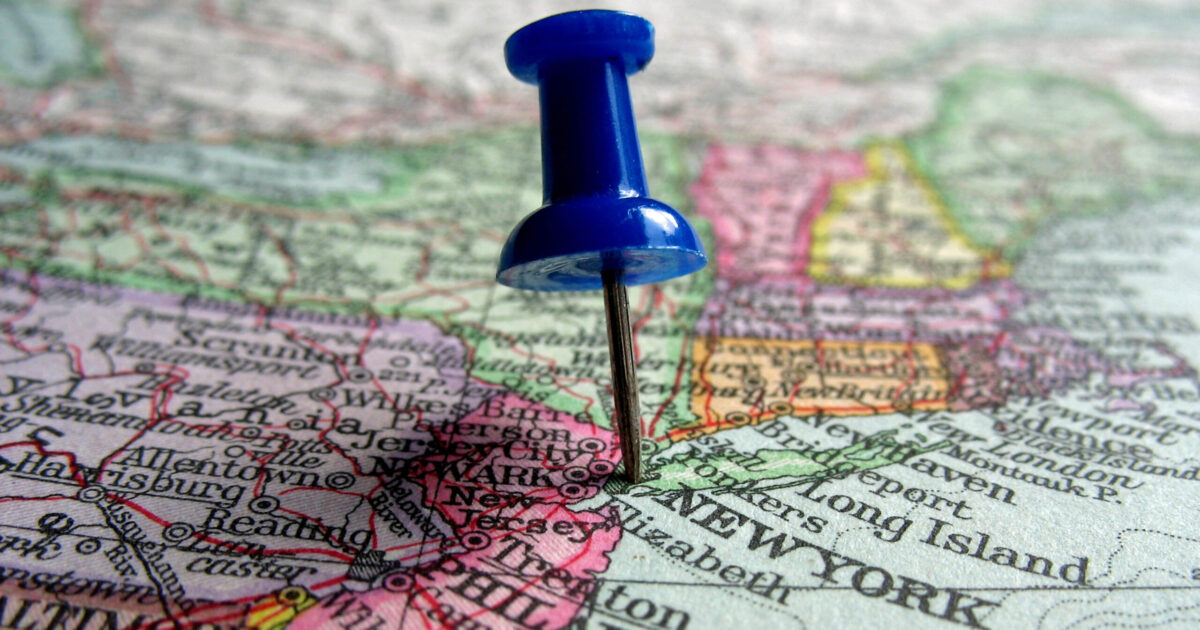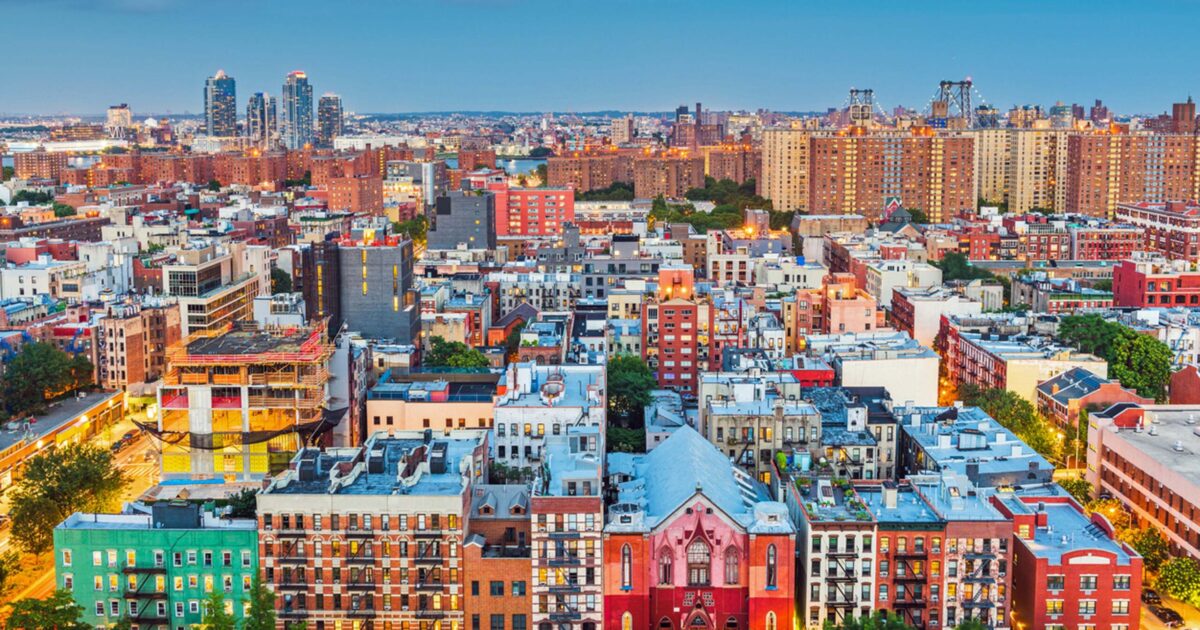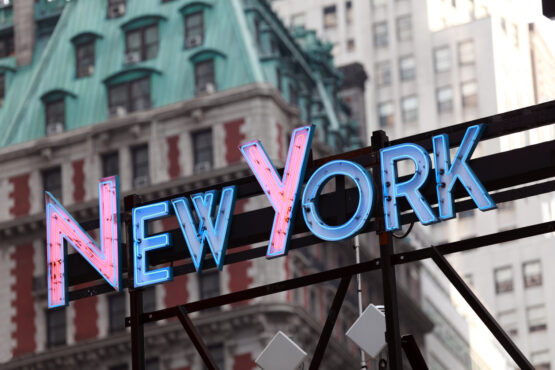From man-made gems like the Statue of Liberty and the Empire State Building to scenic wonders such as Niagara Falls and the Catskill Mountains, New York State earns its place as a bucket list item for travel nurses and other healthcare professionals (HCPs). However, as the country’s No. 4 most populous state, demand for housing in New York can be staggering, especially in and around New York City (NYC), the nation’s most crowded urban area. Finding travel nurse housing in New York State may take some extra effort, but Vivian Health has gathered essential housing tips and resources to help you kickstart your hunt for the perfect place to stay.
By the Numbers: Working as a New York Travel Nurse

New York is a bounty of riches for a travel RN. The state’s diverse landscapes and four-season climate offer plenty of hiking, skiing, leaf peeping and beach hopping opportunities. In its southernmost corner, the state boasts New York City, one of the world’s truly international cultural and economic capitals. Many consider a stint in NYC as a once-in-a-lifetime experience inspired by imagery from the likes of Sex and the City, Friends, Gossip Girl and too many films to count.
With its massive healthcare sector, New York State is as rich in HCP jobs as it is in scenery and culture. According to the Federal Reserve, healthcare accounts for 12.6% of all New York jobs vs. an average of 9.3% of all jobs across the entire U.S., per the Bureau of Labor Statistics.
Based on job listings from Vivian Health during the week of June 24, 2024, travel nursing jobs in New York paid an average of $2,312 per week. During this period, travel nursing salaries in New York were roughly 9% above the national average travel nurse wage and paid a 23% premium over the national average staff nurse rates.
However, you must weigh the state’s wage premiums against its higher cost of living. According to Sperling’s Best Places, New York’s cost of living is 21.5% higher than the national average. That higher average also obscures the significant price differences between the state’s two primary regions, “Downstate” and “Upstate.” The differences between these regions are so substantial that you might even think of them as if they were two different states. They present polar extremes regarding housing costs and living experience.
Downstate vs. Upstate – New York’s Tale of Two Regions
Downstate New York includes New York City and its immediate suburbs, including all of Long Island. A plethora of major hospitals offer many potential jobs. In fact, in our list of the top 10 healthcare employers in New York State, all of them are located Downstate, and several additional top hospitals in NYC also often rank among the best in the country.
However, this region is among the most expensive places in the country to live. Based on Sperling’s Best Places data, New York City’s cost of living is 72.5% higher than the national average, which you’ll see reflected in the price of everything from groceries and rent to movie tickets and cocktails. Travel nurses taking contracts there may want to consider ways to economize such as living in shared housing, studio apartments or further from the hospital.
Upstate New York includes the rest of the state, stretching from New England in the East to the Great Lakes in the West and all the up to the Canadian border. It features a mix of smaller cities like Albany, Buffalo, Rochester and Syracuse, smaller towns, and mountainous or agricultural rural areas. Costs in this region are more in line with the rest of the country.
Housing Costs for Transient Nurses in New York’s Two Regions

Many nurses who travel solo or as a couple typically consider one-bedroom apartments the ideal size for their stay. Therefore, we looked at the rent for this apartment category in both Downstate and Upstate NY. The Department of Housing and Urban Development (HUD) calculates fair market rents for apartments based on the local rental rates for modest apartments in each size category.
There’s no question that housing in Upstate NY is more affordable. In Hamilton County, New York’s most rural county, HUD’s 2024 fair market one-bedroom apartment rent was $770. For Erie County, home to Buffalo, New York’s second-largest city, it was $908. In Albany County, home to the state capital, it was $1,079. Such rents are representative of Upstate.
Downstate is another story. For instance, in Westchester and Nassau counties, suburban areas adjacent to New York City, HUD’s 2024 one-bedroom fair market rents were $1,669 and $1,914, respectively. Meanwhile, HUD combines New York City’s five counties, or boroughs, into a single fair market rent of $2,170 for a one-bedroom.
However, hidden within this city-wide average is the fact that housing is typically cheaper in New York City’s so-called outer boroughs (i.e., Brooklyn, Queens, Staten Island and The Bronx). Conversely, rental costs in Manhattan, the city’s central borough, are among the highest in the country.
One cost-saving option for travel nurses Downstate, especially in NYC, is living without owning or operating a car thanks to dense, walkable neighborhoods and extensive, 24-hour public transportation. The region’s system of commuter rails, buses, subway and even ferries reaches beyond New York State’s borders into a tri-state area. This elaborate system means nurses looking to work in NYC can consider out-of-state housing, such as rentals in Fairfield County (CT) or Hudson, Bergen and Essex Counties (NJ). Various transit systems bring tens of thousands of commuters from those counties into New York City each day.
Considerations When Choosing Travel Nurse Housing in New York

Flexible Terms and Furnished Apartments
Wherever you choose to take a travel nursing role in New York, here are some general considerations. Many landlords only offer rental housing for one-year minimum leases, which isn’t helpful for HCPs taking 90-day or 180-day travel jobs. Flexibility is crucial, such as a landlord’s willingness to rent weekly or for a preset period or offer a month-to-month lease. Unfortunately, these options often cost more than longer-term leases. Travel nurses typically also want to find fully furnished housing since hauling furniture from location to location can be a costly and laborious burden.
Proximity to Work
Work-life balance is a priority for many travel nurses. Living near a healthcare facility can offer shorter commutes and more time to enjoy your travel experience. Proximity also helps with picking up extra shifts or in emergencies. All of this certainly applies Upstate. However, you should carefully weigh workplace proximity Downstate against the cost of housing near the facility.
While numerous prestigious hospitals are in NYC’s expensive Manhattan borough, many staff nurses commute from less expensive areas like the outer boroughs and suburbs. You can, too. Mass transit makes it all possible while avoiding the region’s notorious traffic. Most transit operates around the clock, and online tools like Google Maps can help you explore transit routes and timings between your employer and potential housing options.
Seasonal Variations and Short-Term Housing Challenges
New York is a year-round tourist destination with a mix of activities drawing visitors in all four seasons. However, tourism often peaks during the summer and between Thanksgiving and New Year’s Day. This spike is especially true in New York City. Steer clear of housing in Manhattan’s heavily touristed areas during such periods. The summer can also put a housing crunch in popular beach, mountain and lake destinations, such as the Hamptons, Catskill Mountains and Finger Lakes region, where many NYC residents take summer vacations.
Where to Find Travel Nurse Housing in New York

Various websites and services offer ways to find travel nurse housing in New York. We focus primarily on listing services and providers where rooms come already furnished and that permit terms of less than a year. We group sites into a few main categories, as listed below.
Vacation Rental Sites
Vacation rental sites such as Airbnb and Vrbo can be an option for travel nurses. Housing choices range from entire homes to individual rooms, sometimes shared with the owner or a full-time tenant. These sites may best serve Upstate or suburban Downstate locations. Meanwhile, an NYC law bans most housing rentals for less than 30 days. Although most travel nurses need housing for 30 days or longer, the limitations on shorter-term stays mean fewer listings on these vacation-oriented sites than you might expect for a city of the Big Apple’s size.
Long-Term Stay Hotels
While it might seem counterintuitive to stay in a hotel for more than a couple of weeks, a variety of lodging brands today cater to long-term stays of 30 days or more. Such extended-stay hotels often include a kitchenette and separate seating area so that the room can serve as your fully furnished home away from home. Several provide free hot breakfast, which is a great perk for a busy nurse. The business model of such chains features lower prices if you book a long-term stay, with deals for month-long rentals, compared to most other hotel chains.
This type of hotel is more common and affordable in suburban New York City and Upstate New York compared with NYC. Some options in this category include:
- Extended Stay America: Specializes in extended stays with fully equipped kitchens and on-site laundry facilities.
- Residence Inn by Marriott: Offers spacious suites with full kitchens and separate living areas.
- Homewood Suites by Hilton: Provides suites with full kitchens, free hot breakfast and evening socials.
- Candlewood Suites (by IHG): Features full kitchens, a lending locker for additional appliances and on-site laundry.
- Staybridge Suites (by IHG): Offers full kitchens, complimentary breakfast and social evenings with refreshments.
- TownePlace Suites by Marriott: Provides full kitchens, complimentary breakfast and a home-like environment.
- WoodSpring Suites: Focuses on affordability with in-room kitchens, guest laundry and weekly rates.
- Suburban Extended Stay Hotel (by Choice Hotels): Offers fully equipped kitchens and affordable weekly or monthly rates.
- Hawthorn Suites by Wyndham: Features suites with kitchens, free hot breakfast and evening receptions.
- Element by Westin: Focuses on eco-friendly extended stays with full kitchens and wellness amenities.
Websites for Month-to-Month Rentals
Remote work and travel have become big since the pandemic, and a burgeoning business of shorter-term rental sites for durations between 1 and 12 months has arisen. These can be great for travel nurses, who are typically looking for housing for up to six months. Some sites to consider include:
- Diggz specializes in matching roommates with similar lifestyles and preferences, with rooms for rent in multi-family houses or studios for those who prefer solo living.
- Furnished Finder focuses on fully furnished apartments and rooms available for month-to-month durations. The site includes special data on housing demand for travel nurses and a calculator for budgeting with your travel nursing stipend.
- Landing features housing with 1, 2 or 3 bedrooms, which can be a great option for travel nursing with family. At present, the company only has a limited selection in New York.
Specialty Housing Services for Travel Nurses
Several housing sites market themselves as specifically catering to travel nurses. For instance, Transplant Housing lists housing for travel nurses in fully furnished homes and apartments. Those who list housing on this site are specifically looking for travel nurse occupants, as they’re considered ideal tenants for short-term rentals.
TravelNurseHousing.com offers a similar service and lists furnished rooms, entire homes and cottages geared to travel nurses. However, this is the sister site of Furnished Finder, so there may be a lot of overlap between the listings on both.
Direct Listings By Owners and Lessors
Many individuals may post shorter-term rental options to open platforms such as CraigsList and the Facebook Marketplace in New York, especially New York City. Ads on these sites are often from small owners or primary tenants looking to rent one room in their apartments. Because those sites tend to charge low or no fees for rental listings, you may find more affordable options there compared to sites that charge hefty listing or brokerage fees.
However, the low-cost nature of these ads also means that virtually anyone, even a scammer, can create a listing. Nurses should carefully vet these listings, ideally visiting the location and meeting the landlord or potential roommate in person before any money changes hands. If renting a room from another renter, be sure to see a copy of their signed lease showing a lease expiration date that comes after your planned departure.
Begin Your Travel Journey to the Empire State with Vivian
Whether you’re in an “Empire State of Mind” or considering travel roles in any of the other 49 states or Washington, D.C., Vivian can help you find your ideal travel job in a New York minute. Register for a free account to access listings for nearly 100,000 open travel nurse roles nationwide, with new jobs posting hourly.
Disclosure: We may receive compensation if you click on the included links.
Editor’s Note: This post was updated on October 15, 2024.









